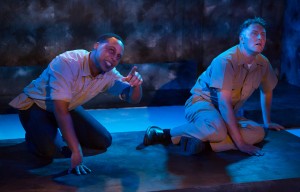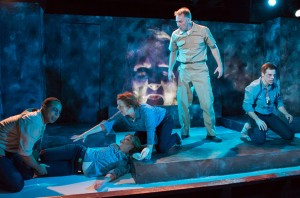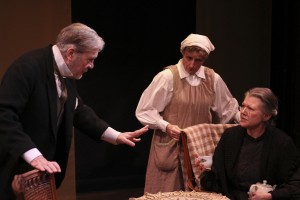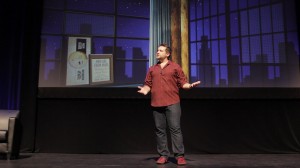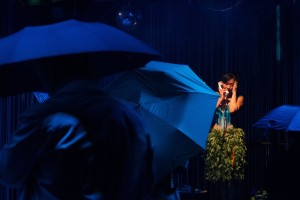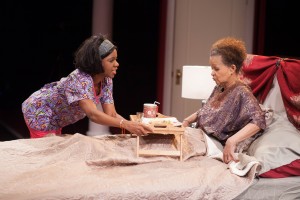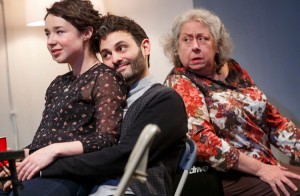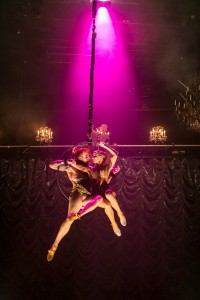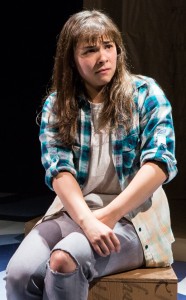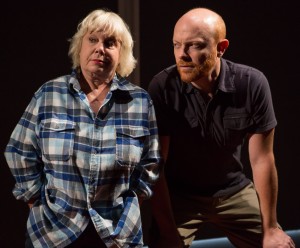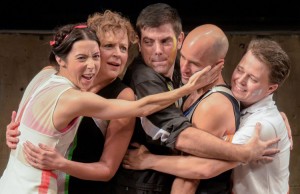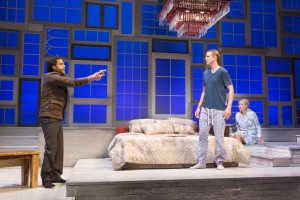The legendary director Harvey Cocks once claimed, “An actor must never be afraid to make a fool of himself.” And real men shouldn’t be afraid to be fools, either. At least that is the perspective of the creators of Real Men: The Musical, the playfully vaudevillian show at the New World Stages, an Off-Broadway multi-theater venue in Midtown Manhattan. This new award-winning musical comedy has been brought to New York City from the Actors’ Playhouse in Coral Gables, Florida. The show is cleverly written by Paul Louis and Nick Santa Maria, with impeccable musical direction by Martin Landry and exquisite arrangements by Manny Schvartzman.
Real Men: The Musical is a man’s view of men. As the characters read to us from the Book of More Men, we learn the truth about what goes on in a real man’s mind. Apparently, not much besides sex and sports. At least they are able to laugh at themselves about it. And sing about it. And play with puppets (and themselves) about it. As the piece follows the men in their journey into married midlife suburban crisis, we learn that they do want to understand why they are so stupid. According to the playbill, the play is set in “Present Day” to suggest that some things never change. It also reads that the place is "Everywhere," but Boynton Beach and Boca Raton sure are recognizable. Jerry Seinfeld's parents would love it. And who doesn't love South Florida?
The musical stars Stephen G. Anthony (I Love You, You’re Perfect, Now Change) along with the writers, Louis (from the 1995 TV series "Jelly Bean Jungle”) and Maria (Secrets Every Smart Traveler Should Know). Under the manly guidance of award-winning director David Arisco, these performers give us a hilarious and harmonious examination into the minds of men. All three performers effortlessly mastered the melodies and harmonies; a real twisted Rat Pack with the Three Stooges. While they were campy at times, that was what they were striving for and they did it well. The inclusion of puppet women heightened their point that men see women as objects with talking heads, breasts and derrières.
Some of the lyrics were hysterical; some were a bit dated—heard them from my ex-husband and his father, in South Florida years ago. But again, they reiterate the point that men are limited in their thinking and that it is a universal disease. The production definitely caters to the older bridge and tunnel crowd. Married and divorced couples will get it but younger theater-goers might need variety in the music and a younger perspective (maybe the son in the song "That’s My Boy" could appear). The music was well-written and performed, reminiscent of the old great standards—but a bit repetitive in certain spots. There was most certainly room for a rock song, or other style of music, too. And while the men can sing, and move well, an audience does like to see nice legs. Not that Anthony's legs weren’t nice—he looks great in drag. While it was especially delightful to hear these real men’s confessions, the character development could have been further expanded.
Particular songs that really hit the mark were "I’m Not with Nick" and "Married Man’s Lament," a hysterical number sung by Louis with help from Maria, Anthony and a giant penis. "That’s My Boy" was a real surprise. It was flawlessly carried by Nick, who has a real sense of character, comedic timing and honest acting. Anthony had a powerful voice, nice hair and could really move his hips. Paul was a hoot with the puppets; he really knew how to work them smoothly into his performance. Plus, he looked great in his cowboy outfit and tutu. They all had undeniable chemistry and it was clear they were enjoying themselves. So we enjoyed them, too. We all knew these fellows. They were our fathers and husbands in true form. It was nice to laugh at them and not get in trouble.
Real Men: The Musical is running through Jan. 2, 2016 at New World Stages (340 West 50th St. between 8th and 9th Aves.) in Manhattan. Check the performance schedule here. Tickets range from $59-$79 and can be purchased by calling 212-239-6200 or visiting Telecharge.com.











